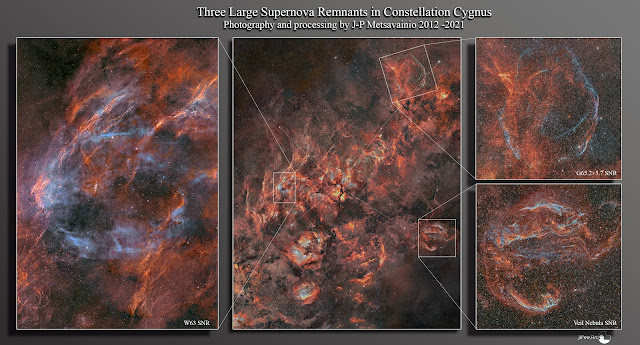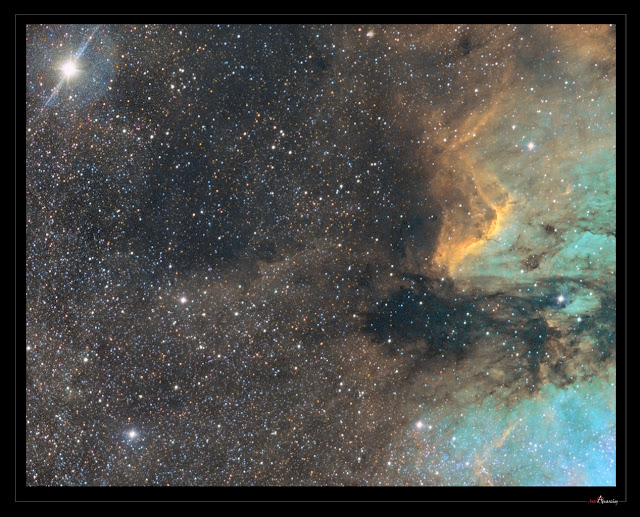COPYRIGHT, PLEASE NOTE
Thursday, December 31, 2020
All my photos from year 2020
The year 2020 has been interesting since I'm between the scopes at the moment. I converted my old Tokina At-x 300 mm f2.8 camera optics and paired it with the Apogee Alta U16 astro camera.
At first it looked like an impossible task since the back focus distance of Tokina lens was way too short for the camera. After some heavy handed modifications (including an angle grinder) I managed to marry those too junks of metal, glass and silicon together. Kind of Frankenstein's monster but worked!
After many years shooting with a long focal length instrument it was like a fresh air to work with wide field tool.
All my photos from the year 2020
Click for a full size poster (2000 x 2800 pixels)
Photo 11, https://astroanarchy.blogspot.com/2020/04/two-ways-to-go-in-same-field-of-view.html
Photo 12, https://astroanarchy.blogspot.com/2020/11/a-supernova-remnant-in-cygnus-g65357-snr.html
This SNR is part of the Cygnus mosaic (Image 21).
Photo 21, https://astroanarchy.blogspot.com/2020/01/deep-in-to-my-heart-ic-1805-in-mapped.html
https://astroanarchy.blogspot.com/2020/12/cygnus-project-grande-finale-for-now.html
Cassiopeia to Cepheus
https://astroanarchy.blogspot.com/2020/12/from-cassiopeia-to-cepheus-eight-years.html
- Sh2-124, https://astroanarchy.blogspot.com/2020/11/sharpless-124-sh2-124.html
- Sh2--124 wide field
- Clouds of Cassiopeia, https://astroanarchy.blogspot.com/2020/11/cassiopeia-mosaic-gets-larger.html
- SNR CTB1, https://astroanarchy.blogspot.com/2020/02/ctb1-supernova-remnant-in-cassiopeia.html
- Simeis 147, https://astroanarchy.blogspot.com/2020/03/the-birth-of-venus.html
- Tulip nebula area, https://astroanarchy.blogspot.com/2020/10/the-tulip-nebula-in-cygnus-sh2-101.html
- Sh2-205, https://astroanarchy.blogspot.com/2020/03/a-rare-image-sharpless-205-and-ngc-1491.html
- NGC 1499, https://astroanarchy.blogspot.com/2020/01/a-deep-view-to-california-nebula-in.html
- Sh2-132, https://astroanarchy.blogspot.com/2020/11/a-new-photo-of-sharpless-132-sh2-132.html
- Sh2-126, https://astroanarchy.blogspot.com/2020/10/new-photo-sharpless-126-in-lacerta.html
- Sh2-216 & 221, https://astroanarchy.blogspot.com/2020/04/two-ways-to-go-in-same-field-of-view.html
- SNR G65.3+5,7,https://astroanarchy.blogspot.com/2020/11/a-supernova-remnant-in-cygnus-g65357-snr.html
- IC 63 & NGC281, https://astroanarchy.blogspot.com/2020/03/ic-63-and-ngc-281.html
- SNR IC443, https://astroanarchy.blogspot.com/2020/03/supernova-remnant-ic-443-wide-field.html
- Bubble to Cave, https://astroanarchy.blogspot.com/2020/03/from-bubble-to-cave-nebula-area.html
- Cygnus, https://astroanarchy.blogspot.com/2020/12/cygnus-project-grande-finale-for-now.html
- Sh2-114, https://astroanarchy.blogspot.com/2020/12/sharpless-114-flying-dragon-nebula.html
- IC 405 & 410, https://astroanarchy.blogspot.com/2020/03/new-photo-deep-in-to-darkness.html
- Cederblad 214,https://astroanarchy.blogspot.com/2020/02/new-photo-of-cederblad-214-cosmic.html
- From CTB1 to Cave,https://astroanarchy.blogspot.com/2020/03/from-cassiopeia-to-cepheus.html
- IC 1805, https://astroanarchy.blogspot.com/2020/01/deep-in-to-my-heart-ic-1805-in-mapped.html
- IC 1396, https://astroanarchy.blogspot.com/2020/01/ic-1396-wide-field-reprocessed.html
- Cassiopeia to Cepheus, https://astroanarchy.blogspot.com/2020/12/from-cassiopeia-to-cepheus-eight-years.html
- Bubble to cave, https://astroanarchy.blogspot.com/2020/03/from-bubble-to-cave-round-ii.html
- Sh2-205 & LBN 696, https://astroanarchy.blogspot.com/2020/03/a-two-frame-mosaic-photo-of-sharpless.html
Monday, December 20, 2021
Cygnus mosaic gets large
The new composition is made so that the veil nebula supernova remnant fits to the field of view.
There are three large supernova remnants visible in this image. The Veil nebula is the most bright of them, other two are really dim and diffused. I spent about 200 exposure hours for those two alone to show them well. I call this trio to the Three musketeers.
I like the new composition, it's very dynamic and shows the whole constellation Cygnus first time ever at this detail level and deepness. Least I haven't seen anything like this before. Image spans now 31 x 23 degrees of sky and has 118 individual frames in it. total exposure time is now around 700 hours and the resolution 20.000 x 25.500 pixels. Image it took over a decade to finalize this photo between 2010 and 2021.
The previous version of this mosaic can be seen here, Great Mosaic of Cygnus
Three large supernova remnants in the same field of view
Click for a large image
ZOOMABLE VERSION
Click for a large image

Three large supernova remnants in constellation Cygnus, the Swan, are in image as colored circles
NOTE, there is an apparent size of the Moon as a scale at lower right corner in a grayscale image.
Beside three supernova remnants there are two Wolf Rayet stars with outer shell formations. NGC 6888, the Crescent Nebula at center of the image and the WR 134, it can be seen as a blue arch just right from the Crescent Nebula, near the Tulip nebula.
Next to the Tulip Nebula lays a Black hole Cygnus X-1, it's marked in small closeup image of the Tulip Nebula at center right in orientation image above.
Constellation Cygnus is an endless source of celestial wonders, both scientifically and aesthetically. For me, as an visual artist, this are of night sky is very inspiring There are endless amount of amazing shapes and structures, I can spend rest of my life just shooting images from this treasury.
Thursday, April 28, 2016
A collection of grayscale photos, Filaments of Cygnus
Cygnus. In this collection there are many of them as a grayscale photos.
Please, click for a large image!
Filaments of Western Cygnus, a two frame mosaic. Color image and info can be seen HERE
Filaments of Western Cygnus, a two frame mosaic. Color image and info can be seen HERE
Filaments of Western Cygnus. Color image and info can be seen HERE
Filaments of Eastern Cygnus. Color image and info can be seen HERE
Wednesday, January 5, 2022
Cygnus Mosaic in Visual Colors
Three Musketeers of Swan
There are three large supernova remnants visible in this image. The Veil nebula is the most bright of them, other two are really dim and diffused. I spent about 200 exposure hours for those two alone to show them well. I call this trio to the Three musketeers.
I like the new composition, it's very dynamic and shows the whole constellation Cygnus first time ever at this detail level and deepness. I haven't seen anything like this before. Image spans now 31 x 23 degrees of sky and has 118 individual frames in it. total exposure time is now around 700 hours and the resolution 20.000 x 25.500 pixels. Image it took over a decade to finalize this photo between 2010 and 2021.
The mapped color version of this mosaic can be seen here, https://astroanarchy.blogspot.com/2021/12/cygnus-mosaic-gets-large.html
Click for a large image
Click for a large image
Beside three supernova remnants there are two Wolf Rayet stars with outer shell formations. NGC 6888, the Crescent Nebula at center of the image and the WR 134, it can be seen as a blue arch just right from the Crescent Nebula, near the Tulip nebula.
Next to the Tulip Nebula lays a Black hole Cygnus X-1
Constellation Cygnus is an endless source of celestial wonders, both scientifically and aesthetically. For me, as an visual artist, this are of night sky is very inspiring There are endless amount of amazing shapes and structures, I can spend rest of my life just shooting images from this treasury.
Wednesday, August 21, 2013
Treasures of Cygnus
Technical data and other information
You will found all the images in this collection from my portfolio with technical details.
http://astroanarchy.zenfolio.com/
Collection of images from the Veil nebula supernova remnant
Note. a large image, ~3MB
I have published this image at Autumn 2012, more info in this blog post:
http://astroanarchy.blogspot.fi/2012/11/veil-nebula-collection-as-poster.html
The Cygnus mosaic
Note. A large image 2200x1400 pixels and ~5MB.
The large mosaic of constellation Cygnus covers 22x14 degrees of sky. Total exposure time with QHY9 astrocam and Baader narrowband filters is ~120h.
A Chinese Dragon Nebula
The large panorama of Cygnus looks very much like a "Chinese Dragon"!
Original blog post here: http://astroanarchy.blogspot.fi/2012/11/a-chinese-dragon.html
Orientation
Tuesday, December 4, 2018
Grande mosaic of Cygnus, 18-panels, over 150 hours and 22 x 14 degrees of sky
I have originally published this image back at December 9, 2011 After that I have shot many details out of this are of sky with much longer focal length instrument. Mainly with Celestron Edge 11" reflecting telescope. I have now updated this photo with a new image material and I thought, that it's a good time to republish this updated image again.
The Great mosaic image of constellation Cygnus has 18 individual panels stitched together seamlessly. Each panel has shot three times for a color image. First I shot the light from an ionized hydrogen (H-alpha), then light from an ionized sulfur (S-II) and last the light from an ionized oxygen (O-III). The final image has a resolution of 15.000 x 10.000 pixels. I shot all frames with the Canon EF 200mm f1.8 camera optics at full open, QHY9 astrocam and Baader narrowband filter set.
There are no noise reduction, star reduction or sharpening used for this mosaic. It's very well in focus due to temp compensating focuser I made for this lens. (At f1.8 the critical focus zone is about 7 metric microns.)

Image is in mapped colours, from the emission of ionized elements, R=Sulphur, G=Hydrogen and B=Oxygen.
Tuesday, November 22, 2011
Cygnus project, the grande finale
Direct link to a 2000x3000 pixel version HERE. (7,5 meg)
(Original one is ~14.000x10.000 pixels)
At top Left, a beautiful open cluster, NGC 6819 , can be faintly seen. (It's well resolved in full res. image)
Two bright objects at bottom middle are Sh2-112 and a bluish Sh2-115. At bottom Right are parts of the North America and Pelicän nebulae visible. The propeller Nebula can be seen at center left. There are many other objects in this large field.
R=80%Hydrogen+20%Sulfur, G=100%Oxygen and B=85%Oxygen+15%Hydrogen to compensate otherwise missing H-beta emission. This composition is very close to a visual spectrum.
Total exposure time for all channels ~15h
Top of light exposures, there are calibration files shot.
H-a, 21 Flat frames
O-III, 21 Flat frames
S-III, 21 Flat frames
All filters:
99 Bias frames
19 Dark frames





















































